Different Effects of Salt Bridges near the Active Site of Cold-Adapted Proteus mirabilis Lipase on Thermal and Organic Solvent Stabilities
Abstract
:1. Introduction
2. Results
2.1. Protein Expression and Purification
2.2. Effects of Temperature and Organic Solvent on the Enzymatic Activity
2.3. Changes in Conformational Flexibility
2.4. Thermal Stability
2.5. Organic Solvent Stability
2.6. Kinetic and Thermodynamic Properties
2.7. Circular Dichroism (CD) Spectra Analysis
3. Discussion
4. Materials and Methods
4.1. Materials
4.2. Structural Modelling
4.3. Site-Directed Mutagenesis
4.4. Protein Expression and Purification
4.5. Enzyme Assay and Thermal Stability
4.6. Activity and Stability in Organic Solvents
4.7. Enzyme Kinetics and Thermodynamics Analysis
4.8. Protein Thermal Shift Analysis
4.9. Quenching of Protein Fluorescence
4.10. CD Spectroscopy
Author Contributions
Funding
Data Availability Statement
Acknowledgments
Conflicts of Interest
References
- Klibanov, A.M. Improving enzymes by using them in organic solvents. Nature 2001, 409, 241–246. [Google Scholar] [CrossRef] [PubMed]
- Klibanov, A.M. Why are enzymes less active in organic solvents than in water? Trends Biotechnol. 1997, 15, 97–101. [Google Scholar] [CrossRef]
- Gorman, L.A.; Dordick, J.S. Organic solvents strip water off enzymes. Biotechnol. Bioeng. 1992, 39, 392–397. [Google Scholar] [CrossRef] [PubMed]
- Stepankova, V.; Damborsky, J.; Chaloupkova, R. Organic co-solvents affect activity, stability and enantioselectivity of haloalkane dehalogenases. Biotechnol. J. 2013, 8, 719–729. [Google Scholar] [CrossRef]
- Kamal, M.Z.; Yedavalli, P.; Deshmukh, M.V.; Rao, N.M. Lipase in aqueous-polar organic solvents: Activity, structure, and stability. Protein Sci. 2013, 22, 904–915. [Google Scholar] [CrossRef] [Green Version]
- Fitzpatrick, P.A.; Ringe, D.; Klibanov, A.M. X-ray crystal structure of cross-linked subtilisin Carlsberg in water vs. acetonitrile. Biochem. Biophys. Res. Commun. 1994, 198, 675–681. [Google Scholar] [CrossRef]
- Allen, K.N.; Bellamacina, C.R.; Ding, X.; Jeffery, C.J.; Mattos, C.; Petsko, G.A.; Ringe, D. An experimental approach to mapping the binding surfaces of crystalline proteins. J. Phys. Chem. 1996, 100, 2605–2611. [Google Scholar] [CrossRef]
- Chakravorty, D.; Parameswaran, S.; Dubey, V.K.; Patra, S. Unraveling the rationale behind organic solvent stability of lipases. Appl. Biochem. Biotechnol. 2012, 167, 439–461. [Google Scholar] [CrossRef]
- Yedavalli, P.; Rao, N.M. Engineering the loops in a lipase for stability in DMSO. Protein Eng. Des. Sel. 2013, 26, 317–324. [Google Scholar] [CrossRef] [Green Version]
- Stepankova, V.; Bidmanova, S.; Koudelakova, T.; Prokop, Z.; Chaloupkova, R.; Damborsky, J. Strategies for stabilization of enzymes in organic solvents. ACS Catal. 2013, 3, 2823–2836. [Google Scholar] [CrossRef]
- Kumar, A.; Dhar, K.; Kanwar, S.S.; Arora, P.K. Lipase catalysis in organic solvents: Advantages and applications. Biol. Proced. Online 2016, 18, 2. [Google Scholar] [CrossRef] [PubMed] [Green Version]
- Priyanka, P.; Tan, Y.; Kinsella, G.K.; Henehan, G.T.; Ryan, B.J. Solvent stable microbial lipases: Current understanding and biotechnological applications. Biotechnol. Lett. 2019, 41, 203–220. [Google Scholar] [CrossRef] [PubMed] [Green Version]
- Doukyu, N.; Ogino, H. Organic solvent-tolerant enzymes. Biochem. Eng. J. 2010, 48, 270–282. [Google Scholar] [CrossRef]
- Korman, T.P.; Bowie, J.U. Crystal structure of Proteus mirabilis lipase, a novel lipase from the Proteus/psychrophilic subfamily of lipase family I.1. PLoS ONE 2012, 7, e52890. [Google Scholar] [CrossRef] [Green Version]
- Kim, J.; Jang, S.H.; Lee, C. An organic solvent-tolerant alkaline lipase from cold-adapted Pseudomonas mandelii: Cloning, expression, and characterization. Biosci. Biotechnol. Biochem. 2013, 77, 320–323. [Google Scholar] [CrossRef] [PubMed] [Green Version]
- Dachuri, V.K.; Lee, C.; Jang, S.H. Organic solvent-tolerant esterase from Sphingomonas glacialis based on amino acid composition analysis: Cloning and characterization of EstSP2. J. Microbiol. Biotechnol. 2018, 28, 1502–1510. [Google Scholar] [CrossRef] [PubMed]
- Hong, D.K.; Jang, S.-H.; Lee, C. Gene cloning and characterization of a psychrophilic phthalate esterase with organic solvent tolerance from an Arctic bacterium Sphingomonas glacialis PAMC 26605. J. Mol. Catal. B Enzym. 2016, 133, S337–S345. [Google Scholar] [CrossRef]
- Guo, H.; Zhang, Y.; Shao, Y.; Chen, W.; Chen, F.; Li, M. Cloning, expression and characterization of a novel cold-active and organic solvent-tolerant esterase from Monascus ruber M7. Extremophiles 2016, 20, 451–459. [Google Scholar] [CrossRef]
- Ganasen, M.; Yaacob, N.; Rahman, R.N.; Leow, A.T.; Basri, M.; Salleh, A.B.; Ali, M.S. Cold-adapted organic solvent tolerant alkalophilic family I.3 lipase from an Antarctic Pseudomonas. Int. J. Biol. Macromol. 2016, 92, 1266–1276. [Google Scholar] [CrossRef]
- Yamashiro, Y.; Sakatoku, A.; Tanaka, D.; Nakamura, S. A cold-adapted and organic solvent-tolerant lipase from a psychrotrophic bacterium Pseudomonas sp. strain YY31: Identification, cloning, and characterization. Appl. Biochem. Biotechnol. 2013, 171, 989–1000. [Google Scholar] [CrossRef]
- Ji, Q.; Xiao, S.; He, B.; Liu, X. Purification and characterization of an organic solvent-tolerant lipase from Pseudomonas aeruginosa LX1 and its application for biodiesel production. J. Mol. Catal. B Enzym. 2010, 66, 264–269. [Google Scholar] [CrossRef]
- Santiago, M.; Ramirez-Sarmiento, C.A.; Zamora, R.A.; Parra, L.P. Discovery, molecular mechanisms, and industrial applications of cold-active enzymes. Front. Microbiol. 2016, 7, 1408. [Google Scholar] [CrossRef] [PubMed]
- Lee, C.; Jang, S.-H.; Chung, H.-S. Improving the stability of cold-adapted enzymes by immobilization. Catalysts 2017, 7, 112. [Google Scholar] [CrossRef]
- Dachuri, V.; Boyineni, J.; Choi, S.; Chung, H.-S.; Jang, S.-H.; Lee, C. Organic solvent-tolerant, cold-adapted lipases PML and LipS exhibit increased conformational flexibility in polar organic solvents. J. Mol. Catal. B Enzym. 2016, 131, 73–78. [Google Scholar] [CrossRef]
- Korman, T.P.; Sahachartsiri, B.; Charbonneau, D.M.; Huang, G.L.; Beauregard, M.; Bowie, J.U. Dieselzymes: Development of a stable and methanol tolerant lipase for biodiesel production by directed evolution. Biotechnol. Biofuels 2013, 6, 70. [Google Scholar] [CrossRef] [PubMed] [Green Version]
- Karshikoff, A.; Nilsson, L.; Ladenstein, R. Rigidity versus flexibility: The dilemma of understanding protein thermal stability. FEBS J. 2015, 282, 3899–3917. [Google Scholar] [CrossRef]
- Shehata, M.; Timucin, E.; Venturini, A.; Sezerman, O.U. Understanding thermal and organic solvent stability of thermoalkalophilic lipases: Insights from computational predictions and experiments. J. Mol. Model. 2020, 26, 122. [Google Scholar] [CrossRef]
- Zha, D.; Xu, L.; Zhang, H.; Yan, Y. Molecular identification of lipase LipA from Pseudomonas protegens Pf-5 and characterization of two whole-cell biocatalysts Pf-5 and Top10lipA. J. Microbiol. Biotechnol. 2014, 24, 619–628. [Google Scholar] [CrossRef] [Green Version]
- Glogauer, A.; Martini, V.P.; Faoro, H.; Couto, G.H.; Müller-Santos, M.; Monteiro, R.A.; Mitchell, D.A.; de Souza, E.M.; Pedrosa, F.O.; Krieger, N. Identification and characterization of a new true lipase isolated through metagenomic approach. Microb Cell Fact 2011, 10, 54. [Google Scholar] [CrossRef] [Green Version]
- Ogino, H.; Miyamoto, K.; Ishikawa, H. Organic-solvent-tolerant bacterium which secretes organic-solvent-stable lipolytic enzyme. Appl. Environ. Microbiol. 1994, 60, 3884–3886. [Google Scholar] [CrossRef] [Green Version]
- Cui, H.; Stadtmüller, T.H.J.; Jiang, Q.; Jaeger, K.-E.; Schwaneberg, U.; Davari, M.D. How to engineer organic solvent resistant enzymes: Insights from combined molecular dynamics and directed evolution study. ChemCatChem 2020, 12, 4073–4083. [Google Scholar] [CrossRef]
- Parvizpour, S.; Hussin, N.; Shamsir, M.S.; Razmara, J. Psychrophilic enzymes: Structural adaptation, pharmaceutical and industrial applications. Appl. Microbiol. Biotechnol. 2021, 105, 899–907. [Google Scholar] [CrossRef] [PubMed]
- Mhetras, N.; Mapare, V.; Gokhale, D. Cold active lipases: Biocatalytic tools for greener technology. Appl. Biochem. Biotechnol. 2021, 193, 2245–2266. [Google Scholar] [CrossRef]
- De Maayer, P.; Anderson, D.; Cary, C.; Cowan, D.A. Some like it cold: Understanding the survival strategies of psychrophiles. EMBO Rep. 2014, 15, 508–517. [Google Scholar] [CrossRef]
- Karan, R.; Capes, M.D.; Dassarma, S. Function and biotechnology of extremophilic enzymes in low water activity. Aquat. Biosyst. 2012, 8, 4. [Google Scholar] [CrossRef] [PubMed] [Green Version]
- Markel, U.; Zhu, L.; Frauenkron-Machedjou, V.J.; Zhao, J.; Bocola, M.; Davari, M.D.; Jaeger, K.-E.; Schwaneberg, U. Are directed evolution approaches efficient in exploring nature’s potential to stabilize a lipase in organic cosolvents? Catalysts 2017, 7, 142. [Google Scholar] [CrossRef] [Green Version]
- Kawata, T.; Ogino, H. Enhancement of the organic solvent-stability of the LST-03 lipase by directed evolution. Biotechnol Prog. 2009, 25, 1605–1611. [Google Scholar] [CrossRef] [PubMed]
- Siddiqui, K.S.; Feller, G.; D’Amico, S.; Gerday, C.; Giaquinto, L.; Cavicchioli, R. The active site is the least stable structure in the unfolding pathway of a multidomain cold-adapted alpha-amylase. J. Bacteriol. 2005, 187, 6197–6205. [Google Scholar] [CrossRef] [Green Version]
- Truongvan, N.; Jang, S.H.; Lee, C. Flexibility and stability trade-off in active site of cold-adapted Pseudomonas mandelii esterase EstK. Biochemistry 2016, 55, 3542–3549. [Google Scholar] [CrossRef]
- Dachuri, V.; Truongvan, N.; DangThu, Q.; Jang, S.H.; Lee, C. Distinct roles of an ionic interaction holding an alpha-helix with catalytic Asp and a beta-strand with catalytic His in a hyperthermophilic esterase EstE1 and a mesophilic esterase rPPE. Extremophiles 2019, 23, 649–657. [Google Scholar] [CrossRef]
- Zaks, A.; Klibanov, A.M. Enzymatic catalysis in organic media at 100 degrees C. Science 1984, 224, 1249–1251. [Google Scholar] [CrossRef] [PubMed]
- Canchi, D.R.; Garcia, A.E. Cosolvent effects on protein stability. Annu. Rev. Phys. Chem. 2013, 64, 273–293. [Google Scholar] [CrossRef] [PubMed]
- Jackson, M.; Mantsch, H.H. Beware of proteins in DMSO. Biochim. Biophys. Acta 1991, 1078, 231–235. [Google Scholar] [CrossRef]
- Ferreira, J.C.; Fadl, S.; Ilter, M.; Pekel, H.; Rezgui, R.; Sensoy, O.; Rabeh, W.M. Dimethyl sulfoxide reduces the stability but enhances catalytic activity of the main SARS-CoV-2 protease 3CLpro. FASEB J. 2021, 35, e21774. [Google Scholar] [CrossRef] [PubMed]
- Hwang, S.; Shao, Q.; Williams, H.; Hilty, C.; Gao, Y.Q. Methanol strengthens hydrogen bonds and weakens hydrophobic interactions in proteins—A combined molecular dynamics and NMR study. J. Phys. Chem. B 2011, 115, 6653–6660. [Google Scholar] [CrossRef] [PubMed]
- Pazhang, M.; Mardi, N.; Mehrnejad, F.; Chaparzadeh, N. The combinatorial effects of osmolytes and alcohols on the stability of pyrazinamidase: Methanol affects the enzyme stability through hydrophobic interactions and hydrogen bonds. Int. J. Biol. Macromol. 2018, 108, 1339–1347. [Google Scholar] [CrossRef]
- Pettersen, E.F.; Goddard, T.D.; Huang, C.C.; Couch, G.S.; Greenblatt, D.M.; Meng, E.C.; Ferrin, T.E. UCSF Chimera—A visualization system for exploratory research and analysis. J. Comput. Chem. 2004, 25, 1605–1612. [Google Scholar] [CrossRef] [Green Version]
- Louis-Jeune, C.; Andrade-Navarro, M.A.; Perez-Iratxeta, C. Prediction of protein secondary structure from circular dichroism using theoretically derived spectra. Proteins 2012, 80, 374–381. [Google Scholar] [CrossRef]
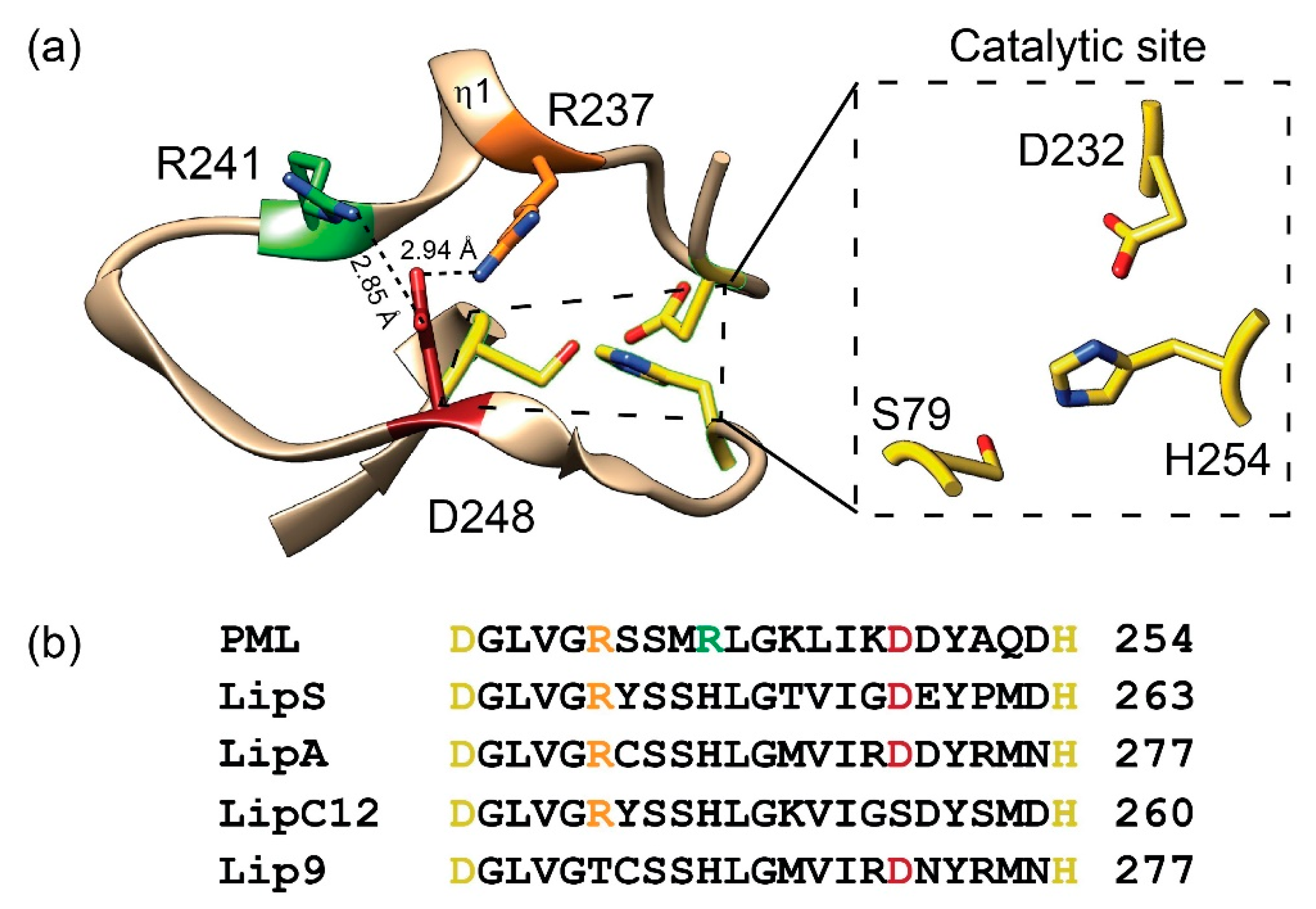
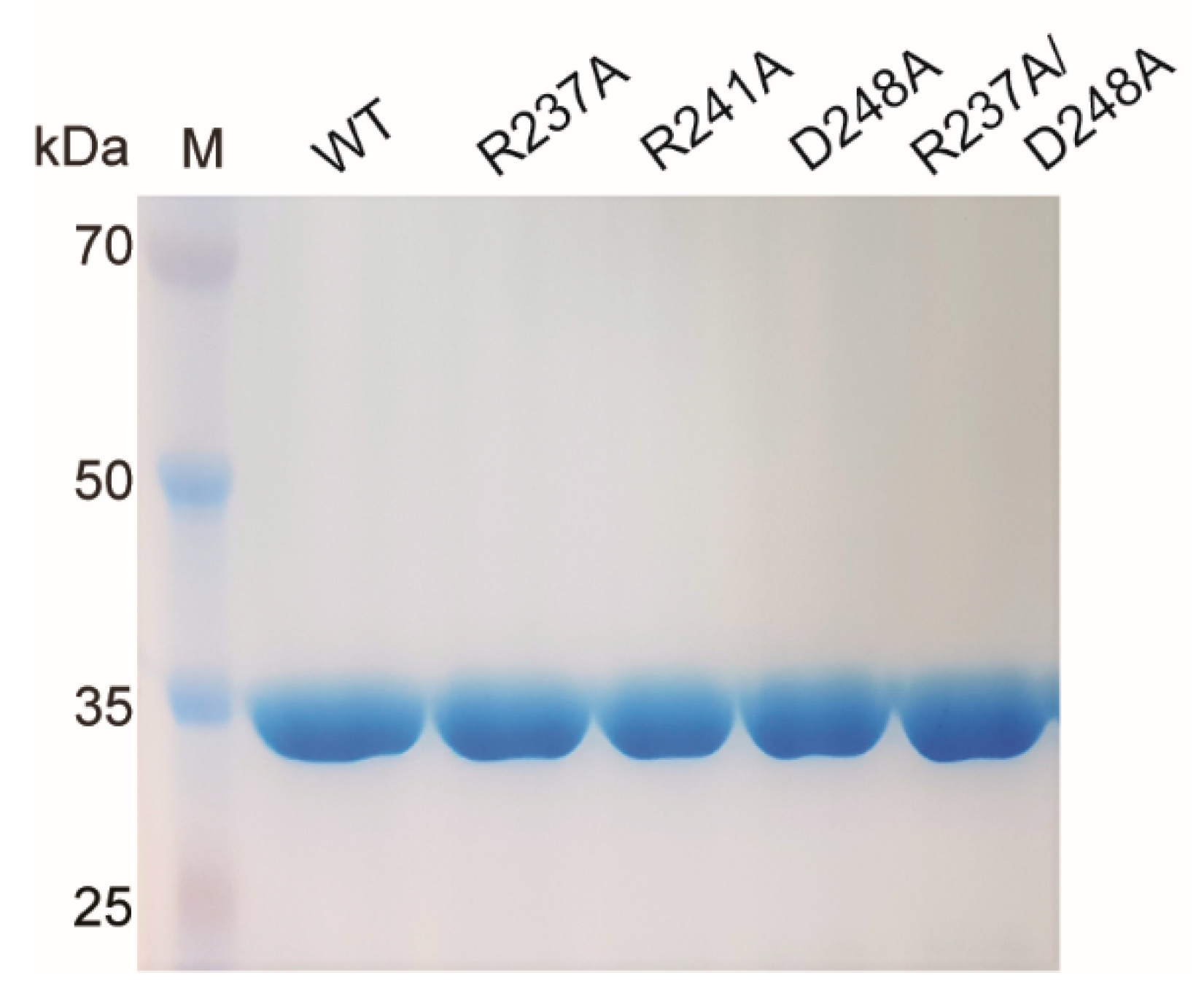
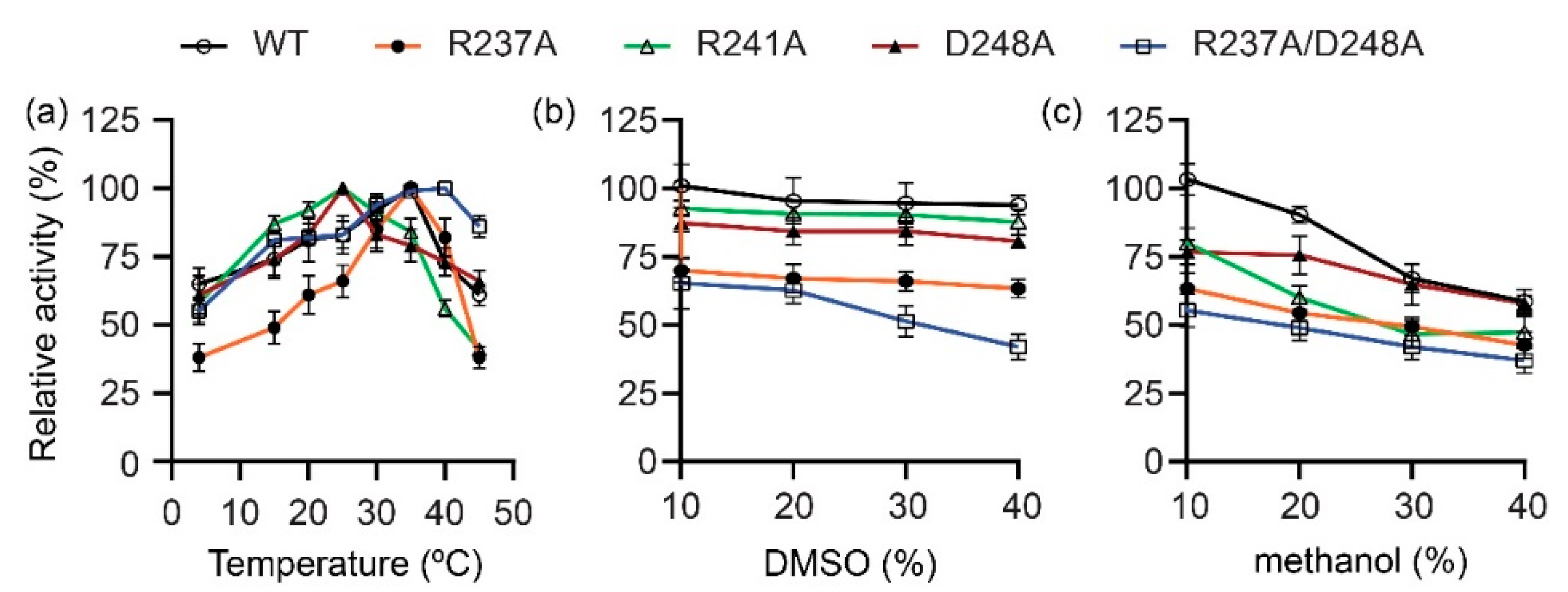
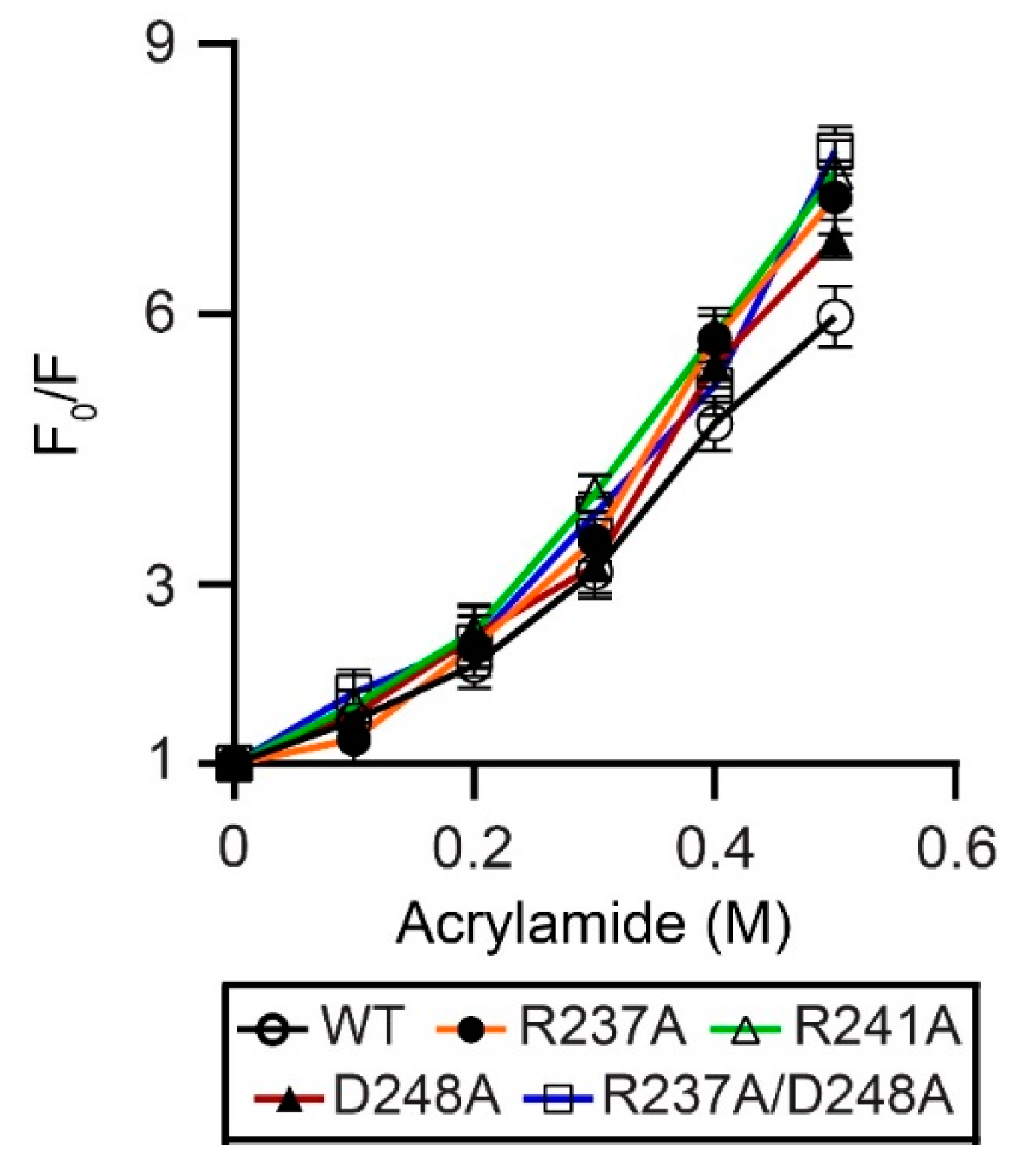
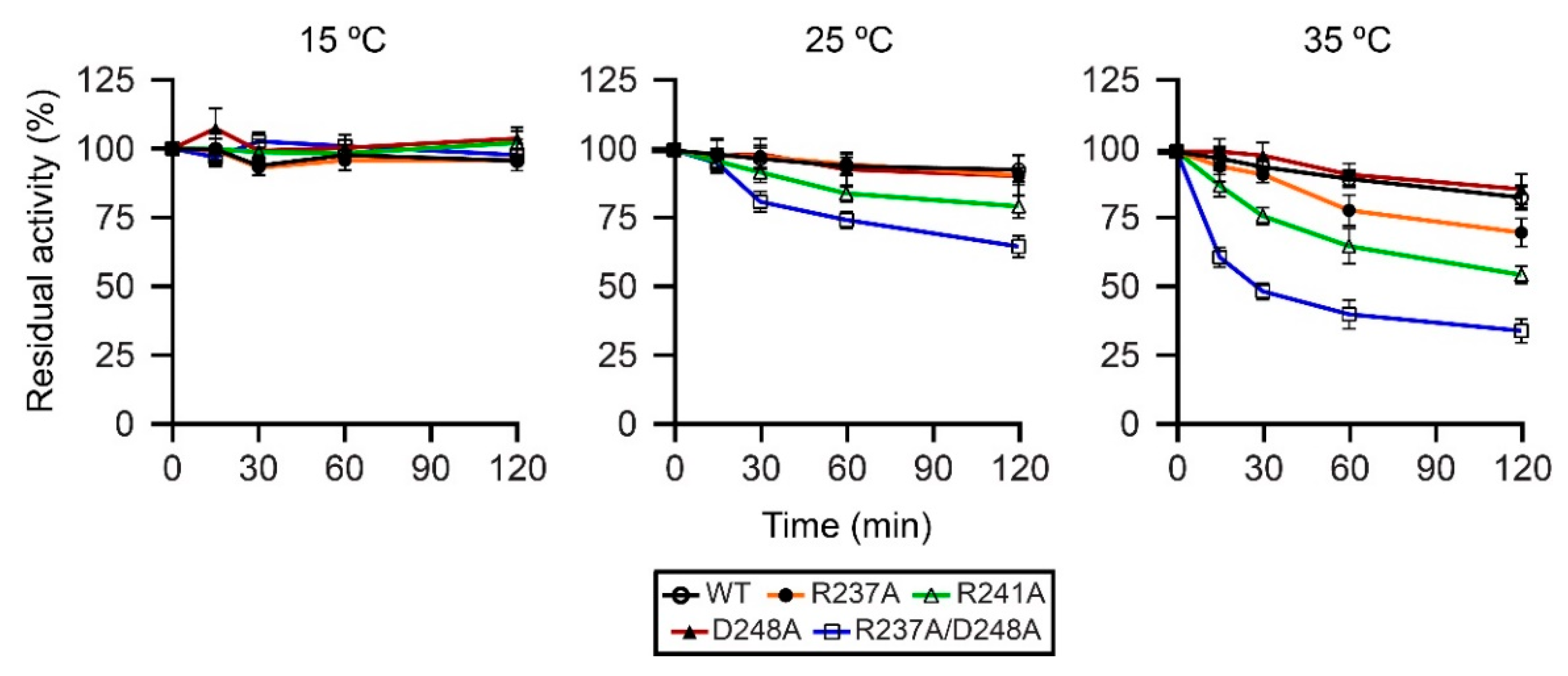
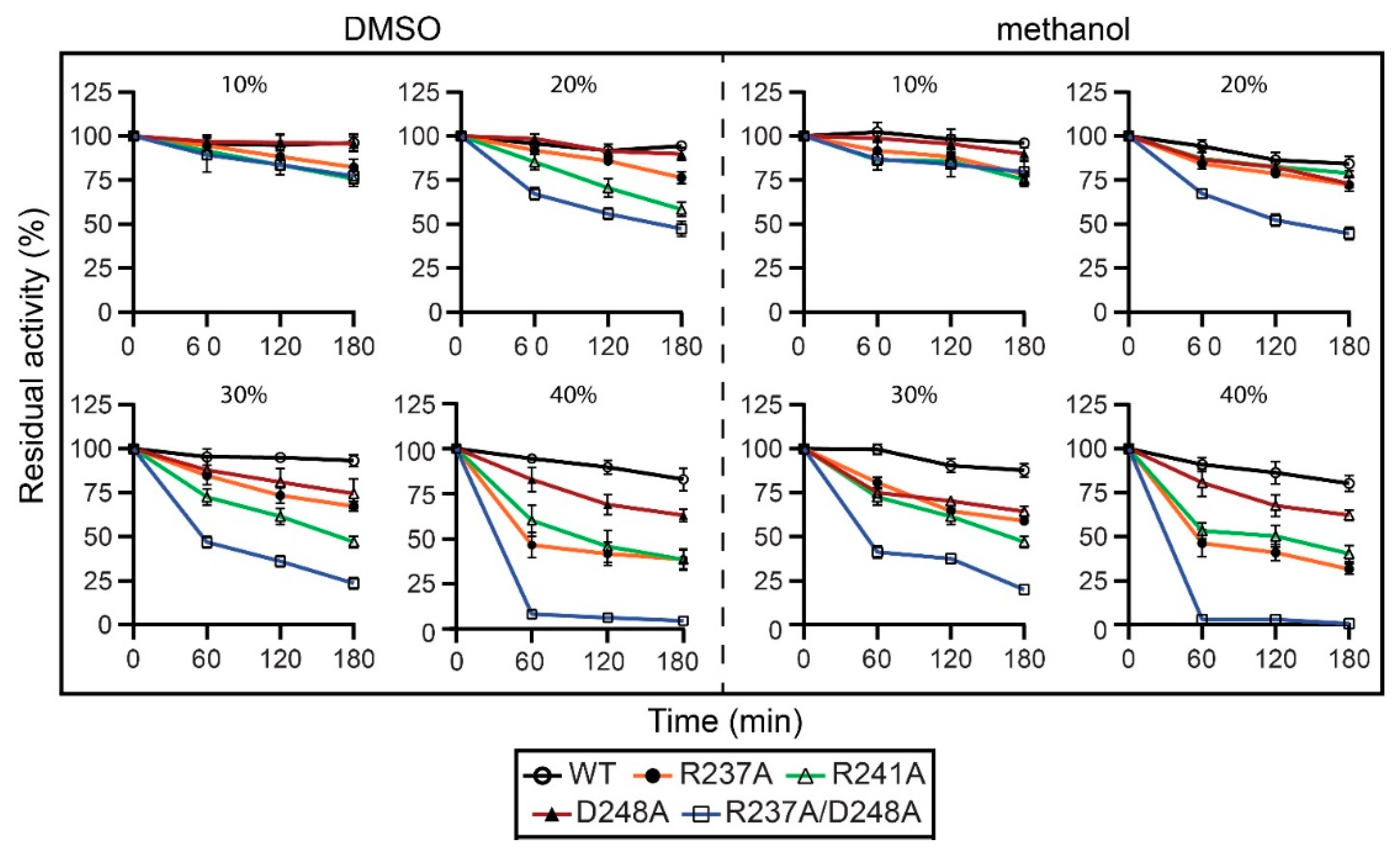

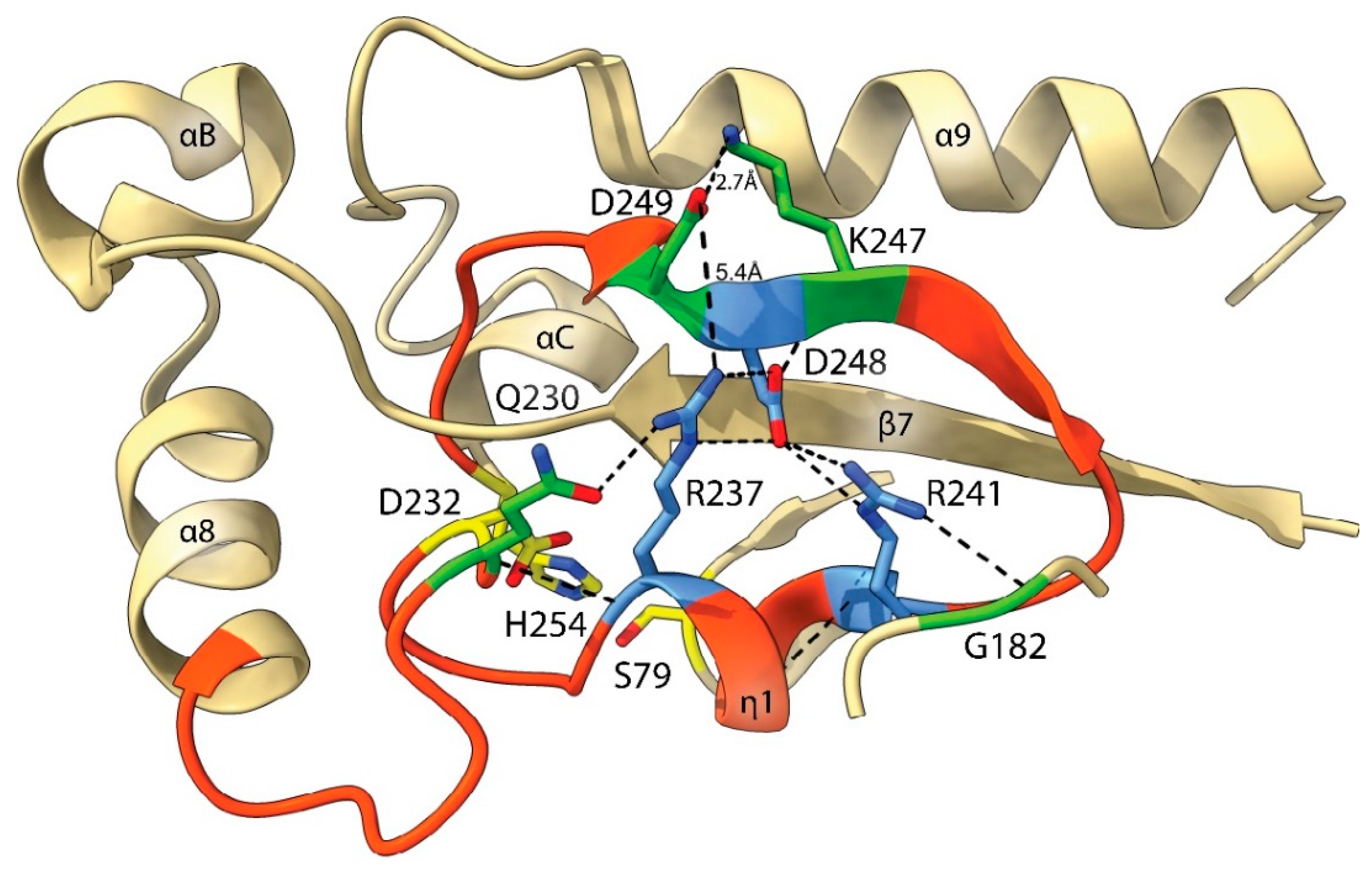
| Total Protein (mg) | Total Activity (units) | Specific Activity (units/mg) | Yield (%) | Purity (%) | ||
|---|---|---|---|---|---|---|
| WT | Cell lysate | 121 | 8935 | 74 | 100 | 25 |
| HisTrap | 14 | 3457 | 247 | 39 | 83 | |
| Q-Sepharose | 11 | 3269 | 297 | 37 | 100 | |
| R237A | Cell lysate | 73 | 8673 | 119 | 100 | 21 |
| HisTrap | 9 | 4569 | 508 | 53 | 90 | |
| Q-Sepharose | 6 | 3389 | 565 | 39 | 100 | |
| R241A | Cell lysate | 52 | 2336 | 45 | 100 | 26 |
| HisTrap | 7 | 976 | 139 | 42 | 80 | |
| Q-Sepharose | 5 | 874 | 175 | 37 | 100 | |
| D248A | Cell lysate | 71 | 3965 | 56 | 100 | 19 |
| HisTrap | 11 | 2387 | 217 | 60 | 73 | |
| Q-Sepharose | 7 | 2086 | 298 | 53 | 100 | |
| R237A/ D248A | Cell lysate | 93 | 10715 | 115 | 100 | 14 |
| HisTrap | 7 | 4571 | 653 | 43 | 77 | |
| Q-Sepharose | 5 | 4239 | 848 | 40 | 100 |
| Concentration (%) | Tm (°C) | |||||
|---|---|---|---|---|---|---|
| WT | R237A | R241A | D248A | R237A/D248A | ||
| buffer | 64.9 ± 0.3 | 65.0 ± 0.6 | 62.2 ± 0.2 | 62.8 ± 0.1 | 63.4 ± 0.2 | |
| DMSO | 10 | 61.6 ± 0.8 | 62.1 ± 0.7 | 63.6 ± 0.3 | 62.4 ± 0.1 | 63.1 ± 0.5 |
| 20 | 56.5 ± 0.6 | 57.2 ± 0.2 | 56.1 ± 0.9 | 57.9 ± 0.4 | 55.8 ± 0.7 | |
| 30 | 46.5 ± 1.9 | 46.9 ± 0.4 | 47.2 ± 0.4 | 46.3 ± 1.1 | 45.9 ± 0.9 | |
| 40 | 39.6 ± 1.4 | 40.3 ± 0.9 | 38.9 ± 0.7 | 41.1 ± 0.9 | 40.8 ± 1.1 | |
| methanol | 10 | 60.4 ± 0.9 | 59.8 ± 0.3 | 60.7 ± 1.2 | 59.3 ± 0.5 | 61.1 ± 0.6 |
| 20 | 53.4 ± 0.4 | 54.1 ± 1.3 | 53.9 ± 0.6 | 54.5 ± 0.7 | 54.3 ± 0.9 | |
| 30 | 43.4 ± 1.1 | 42.7 ± 0.5 | 43.1 ± 0.8 | 43.5 ± 1.4 | 42.8 ± 0.9 | |
| 40 | 36.2 ± 1.7 | 35.4 ± 2.2 | 34.5 ± 1.4 | 36.1 ± 2.3 | 35.7 ± 1.9 |
| Km (µM) | kcat (S−1) | kcat/Km (µM−1 S−1) | ΔG‡ (kJ mol−1) | ΔH‡ (kJ mol−1) | TΔS‡ (kJ mol−1) | |
|---|---|---|---|---|---|---|
| WT | 370 ± 12 | 59 ± 4 | 0.16 ± 0.02 | 64.0 | 17.4 | −46.6 |
| R237A | 241 ± 7 | 42 ± 1 | 0.18 ± 0.01 | 62.3 | 17.4 | −44.9 |
| R241A | 234 ± 15 | 58 ± 9 | 0.24 ± 0.03 | 64.2 | 17.3 | −46.9 |
| D248A | 177 + 21 | 53 ± 8 | 0.30 ± 0.10 | 64.3 | 12.8 | −51.5 |
| R237A/ D248A | 716 ± 42 | 234 ± 10 | 0.32 ± 0.40 | 56.5 | 10.6 | −45.8 |
Publisher’s Note: MDPI stays neutral with regard to jurisdictional claims in published maps and institutional affiliations. |
© 2022 by the authors. Licensee MDPI, Basel, Switzerland. This article is an open access article distributed under the terms and conditions of the Creative Commons Attribution (CC BY) license (https://creativecommons.org/licenses/by/4.0/).
Share and Cite
Dachuri, V.; Jang, S.-H.; Lee, C. Different Effects of Salt Bridges near the Active Site of Cold-Adapted Proteus mirabilis Lipase on Thermal and Organic Solvent Stabilities. Catalysts 2022, 12, 761. https://doi.org/10.3390/catal12070761
Dachuri V, Jang S-H, Lee C. Different Effects of Salt Bridges near the Active Site of Cold-Adapted Proteus mirabilis Lipase on Thermal and Organic Solvent Stabilities. Catalysts. 2022; 12(7):761. https://doi.org/10.3390/catal12070761
Chicago/Turabian StyleDachuri, VinayKumar, Sei-Heon Jang, and ChangWoo Lee. 2022. "Different Effects of Salt Bridges near the Active Site of Cold-Adapted Proteus mirabilis Lipase on Thermal and Organic Solvent Stabilities" Catalysts 12, no. 7: 761. https://doi.org/10.3390/catal12070761
APA StyleDachuri, V., Jang, S.-H., & Lee, C. (2022). Different Effects of Salt Bridges near the Active Site of Cold-Adapted Proteus mirabilis Lipase on Thermal and Organic Solvent Stabilities. Catalysts, 12(7), 761. https://doi.org/10.3390/catal12070761






